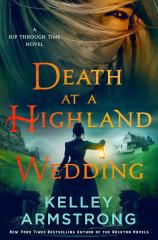Death at a Highland Wedding: A Rip Through Time Novel
Review
Death at a Highland Wedding: A Rip Through Time Novel
The fourth and latest entry in Kelley Armstrong’s delightful time-travel mystery series, DEATH AT A HIGHLAND WEDDING, might be my favorite one yet. Mallory Atkinson, a 21st-century Canadian detective who has traveled back in time to the 1870s, journeys with her employer, Duncan Gray, along with his family and friends, to Scotland for the wedding of Hugh McCreadie's sister.
The bride is Fiona, and she has demanded Hugh’s presence, although he has been estranged from his family. She's marrying Archie Cranston, a friend of both Hugh and Duncan. The relationships are entwined and awkward at times because of past peccadilloes, but we are able to quickly separate the good people from the bad. Or at least we think so.
When a mother wildcat is found dead in one of the traps that were set on Archie’s estate, they are all horrified. Setting out traps is terribly dangerous to people, as well as to wildlife, and the gamekeeper who Archie hired is a truly awful person. The mother cat died, leaving behind several kittens, and one was injured in the trap. When Duncan, Mallory and Hugh find out that the wildcat was poisoned and then put into the trap to make it look like it died there, the mystery is afoot.
The suspense deepens as the best man, Ezra Sinclair, is found dead. The local constable is laughably inept, so Hugh --- who is a detective, a criminal officer with the Edinburgh police --- along with Mallory and Duncan, decide to investigate. Duncan is a doctor and a scientist who has dabbled in forensic pathology. Both men have learned much from Mallory and her ability to share modern police techniques, and they are further motivated to find the killer when Archie is arrested for the murder.
"While it is possible to read DEATH AT A HIGHLAND WEDDING as a stand-alone, especially with the helpful brief introduction that Armstrong provides at the beginning, you'll enjoy the book much more having read the three previous installments."
What follows is a masterful game of cat and mouse as the three try to find clues as to why Ezra was murdered. The questions abound. Was he mistaken for Archie since he was wearing Archie's distinctive overcoat? Does the homicide have anything to do with the poisoned wildcat? Why would anyone want to kill Ezra, who was well liked by all? Why did Archie hire the gamekeeper, who is a hateful person?
Armstrong excels at writing brilliant murder mysteries with plots that are replete with red herrings, truly evil characters, people with noble intentions, and many twists and turns. In this novel, she has us intrigued from the start. Mallory's observations about life in the past as seen through her modern mindset also make for some incredibly perceptive realizations.
It's an eye-opening experience to realize that 150 years ago, people worked seven days a week and were lucky to have Sunday mornings off to attend church. We look back at that with horror, feeling superior because we know that with a 40-hour work week, people are "more productive with time off to rest and enjoy themselves. And yet, this has been a thing for a century, despite studies showing that employees can do as much by working less." But a four-day work week? We’re not ready for that.
There's also sharp commentary on the vast divide between the rich and the poor. Archie bought an estate that had been a place where the Highlanders rented land and had lived for generations. When the previous owner bought the property, he dispossessed the people and forbade them from hunting on his land. Those who lost their homes were understandably angry. The locals were invested in conservation of the land as they needed it to survive. But Armstrong writes, "These days, it seems those with money wish to keep their land entirely for themselves, driving everyone else off it, as if they could possibly use all this land and its resources."
The difference between views of land and ownership in the past and future is further demonstrated when Mallory muses that when her paternal grandparents owned a farm, they wouldn't want people walking on their land and chopping down trees or fishing. But in the past, tradition was that land in the Highlands was hunted and fished and managed by tenants who rented it. When the newly rich bought land and built grand estates, they didn't understand or respect that, which caused problems that Armstrong highlights in the story.
There's a lot going on, and Mallory must discover who the murderer is before an innocent man is wrongly accused. With many possible suspects and victims coming out of the woodwork, the prospect of succeeding seems insurmountable.
The final reveal of the culprit is unexpected, but we realize that Armstrong left a trail of breadcrumbs all along. There's a definite irony as we circle back and see that several of the characters are not who they had appeared to be. There is also the complex continuation of the romantic relationships between Duncan's sister, Isla, and Hugh, and between Mallory and Duncan.
While it is possible to read DEATH AT A HIGHLAND WEDDING as a stand-alone, especially with the helpful brief introduction that Armstrong provides at the beginning, you'll enjoy the book much more having read the three previous installments. You’ll better understand the complexities of the relationships that Mallory has with the others and how she ended up in the past. Her struggle to live in Victorian times after spending over 30 years in the present makes for some humorous situations and interesting commentary. The overarching story, including the relationships among all the characters, builds beautifully. So start at the beginning and enjoy it all.
Reviewed by Pamela Kramer on May 24, 2025
Death at a Highland Wedding: A Rip Through Time Novel
- Publication Date: May 20, 2025
- Genres: Fiction, Historical Fiction, Historical Mystery, Historical Thriller, Mystery, Suspense, Thriller
- Hardcover: 336 pages
- Publisher: Minotaur Books
- ISBN-10: 125032131X
- ISBN-13: 9781250321312




